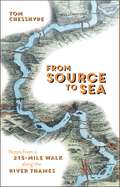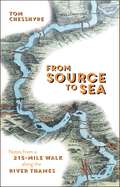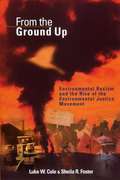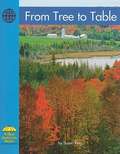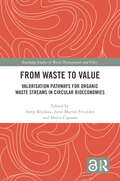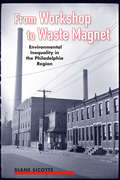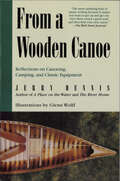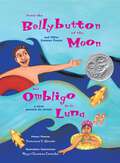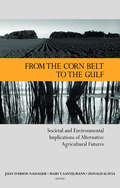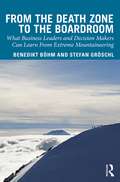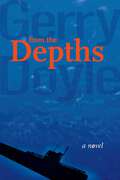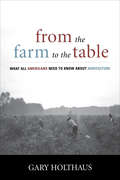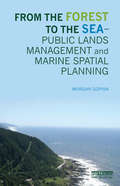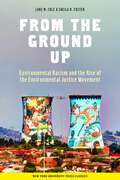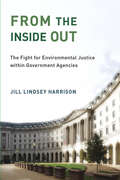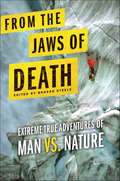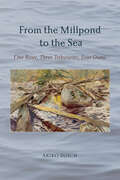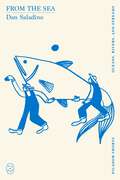- Table View
- List View
From Seed to Plant (Journeys 2014)
by Gail GibbonsFlowers, trees, fruits—plants are all around us, but where do they come from? With simple language and bright illustrations, non-fiction master Gail Gibbons introduces young readers to the processes of pollination, seed formation, and germination. Important vocabulary is reinforced with accessible explanation and colorful, clear diagrams showing the parts of plants, the wide variety of seeds, and how they grow. The book includes instructions for a seed-growing project, and a page of interesting facts about plants, seeds, and flowers. A nonfiction classic, and a perfect companion for early science lessons and curious young gardeners. According to The Washington Post, Gail Gibbons "has taught more preschoolers and early readers about the world than any other children's writer-illustrator." Ms. Gibbons is the author of more than 100 books for young readers, including the bestselling titles From Seed to Plant and Monarch Butterfly. Her many honors include the Washington Post/Childrens Book Guild Nonfiction Award and the NSTA Outstanding Science Trade Book Award. From Seed to Plant was included in the Common Core State Standards Appendix B.
From Seed to Pumpkin
by Wendy PfefferIn the fall, pumpkins are everywhere: in the garden, in the supermarkets, and on doorsteps. But do you know how they grow from a tiny yellow seed to a big orange pumpkin? Read and find out! <p><p>[This text is listed as an example that meets Common Core Standards in English language arts for K-1 at http://www.corestandards.org.]</p>
From Seed to Sunflower
by Dr Gerald LeggThis basic introduction uses the example of a sunflower to describe the year-long process by which a seed becomes a plant that can grow seeds of its own. Though the illustrations often employ interesting perspectives, their tones are unappealing garish. Brief Sunflower Facts and a growth time line are appended.
From Source to Sea: Notes from a 215-Mile Walk Along the River Thames
by Tom ChesshyreAuthors, artists and amblers have always felt the pull of the Thames, and now Tom Chesshyre is following in their footsteps. He’s walking more than 200 miles from the Cotswolds to the North Sea. Seeing some familiar sights through new eyes, Chesshyre explores the living present and remarkable past of England’s longest and most iconic river.
From Source to Sea: Notes from a 215-Mile Walk Along the River Thames
by Tom ChesshyreAuthors, artists and amblers have always felt the pull of the Thames, and now Tom Chesshyre is following in their footsteps. He’s walking more than 200 miles from the Cotswolds to the North Sea. Seeing some familiar sights through new eyes, Chesshyre explores the living present and remarkable past of England’s longest and most iconic river.
From Source to Sea: Notes from a 215-Mile Walk Along the River Thames
by Tom ChesshyreAuthors, artists and amblers have always felt the pull of the Thames, and now Tom Chesshyre is following in their footsteps. He’s walking more than 200 miles from the Cotswolds to the North Sea. Seeing some familiar sights through new eyes, Chesshyre explores the living present and remarkable past of England’s longest and most iconic river.
From Source to Sea: Notes from a 215-Mile Walk Along the River Thames
by Tom ChesshyreAuthors, artists and amblers have always felt the pull of the Thames, and now Tom Chesshyre is following in their footsteps. He’s walking more than 200 miles from the Cotswolds to the North Sea. Seeing some familiar sights through new eyes, Chesshyre explores the living present and remarkable past of England’s longest and most iconic river.
From The Ground Up: Environmental Racism and the Rise of the Environmental Justice Movement
by Luke W. Cole Sheila R. FosterWhen Bill Clinton signed an Executive Order on Environmental Justice in 1994, the phenomenon of environmental racism--the disproportionate impact of environmental hazards, particularly toxic waste dumps and polluting factories, on people of color and low-income communities--gained unprecedented recognition. Behind the President's signature, however, lies a remarkable tale of grassroots activism and political mobilization. Today, thousands of activists in hundreds of locales are fighting for their children, their communities, their quality of life, and their health. From the Ground Up critically examines one of the fastest growing social movements in the United States, the movement for environmental justice. Tracing the movement's roots, Luke Cole and Sheila Foster combine long-time activism with powerful storytelling to provide gripping case studies of communities across the U. S--towns like Kettleman City, California; Chester, Pennsylvania; and Dilkon, Arizona--and their struggles against corporate polluters. The authors effectively use social, economic and legal analysis to illustrate the historical and contemporary causes for environmental racism. Environmental justice struggles, they demonstrate, transform individuals, communities, institutions and even the nation as a whole.
From Tree to Table
by Susan RingThis book reviews the process of gathering, making, and selling maple syrup.
From Waste to Value: Valorisation Pathways for Organic Waste Streams in Circular Bioeconomies (Routledge Studies in Waste Management and Policy)
by Antje Klitkou Arne Martin Fevolden Marco CapassoFrom Waste to Value investigates how streams of organic waste and residues can be transformed into valuable products, to foster a transition towards a sustainable and circular bioeconomy. The studies are carried out within a cross-disciplinary framework, drawing on a diverse set of theoretical approaches and defining different valorisation pathways. Organic waste streams from households and industry are becoming a valuable resource in today’s economies. Substances that have long represented a cost to companies and a burden for society are now becoming an asset. Waste products, such as leftover food, forest residues and animal carcasses, can be turned into valuable products such as biomaterials, biochemicals and biopharmaceuticals. Exploiting these waste resources is challenging, however. It requires that companies develop new technologies and that public authorities introduce new regulation and governance models. This book helps policy-makers govern and regulate bio-based industries, and helps industry actors to identify and exploit new opportunities in the circular bioeconomy. Moreover, it provides important insights for all students and scholars concerned with renewable energy, sustainable development and climate change.
From Workshop to Waste Magnet: Environmental Inequality in the Philadelphia Region
by Diane SicotteLike many industrialized regions, the Philadelphia metro area contains pockets of environmental degradation: neighborhoods littered with abandoned waste sites, polluting factories, and smoke-belching incinerators. However, other neighborhoods within and around the city are relatively pristine. This eye-opening book reveals that such environmental inequalities did not occur by chance, but were instead the result of specific policy decisions that served to exacerbate endemic classism and racism. From Workshop to Waste Magnet presents Philadelphia's environmental history as a bracing case study in mismanagement and injustice. Sociologist Diane Sicotte digs deep into the city's past as a titan of American manufacturing to trace how only a few communities came to host nearly all of the area's polluting and waste disposal land uses. By examining the complex interactions among economic decline, federal regulations, local politics, and shifting ethnic demographics, she not only dissects what went wrong in Philadelphia but also identifies lessons for environmental justice activism today. Sicotte's research tallies both the environmental and social costs of industrial pollution, exposing the devastation that occurs when mass quantities of society's wastes mix with toxic levels of systemic racism and economic inequality. From Workshop to Waste Magnet is a compelling read for anyone concerned with the health of America's cities and the people who live in them.
From a Wooden Canoe: Reflections on Canoeing, Camping, and Classic Equipment
by Jerry DennisIn these acclaimed essays, Jerry Dennis, widely recognized as one of our finest writers on nature and the outdoors, turns his attention to old passions and finds new reasons to appreciate them. This engaging collection explores the quintessential American sports of canoeing and camping and pays tribute to the things worth keeping, from wooden canoes and pocket knives to cast-iron skillets, long-johns, canvas tents, and fine moments on the water. At a deeper level, it is about respect—for our possessions, for the natural world, for one another—and about the pleasures of a life well spent.From a Wooden Canoe is a celebration of the good things and the simple pleasures of life outdoors. It is a book to be treasured, to be read on winter evenings and rainy afternoons, and to be kept handy on a cabin shelf.PRAISE:&“Jerry Dennis knows the good stuff: How to make your matches waterproof; why it&’s good to have a Thermos handy; and how long johns got their name. Mr. Dennis also knows how to write amusing, informative essays about the gear we use outdoors. From a Wooden Canoe is the most satisfying kind of nature writing because it makes you want to get up and get out. Give these essays a good read, and then find your own canoe.&” —Wall Street Journal&“As Jerry Dennis&’s recent book, From a Wooden Canoe, attests, canoes do inspire passion and fidelity. The thirty-one pieces here—most of them from the pages of Canoe and Kayak magazine—include tender odes to hand-hewn wooden paddlers and the rough work of portaging, as well as reflections on other old-school outdoor stuff: homemade waterproof matches, the smell of canvas, and the mysterious, indestructible thermos.&” —The New Yorker&“Dennis writes concise, well-informed, witty prose; his tone is friendly and appreciative of tradition without being maudlin. The celebratory tone of most of the essays is nicely tempered by a send-up of curmudgeons and a concluding essay that might have come from O&’Neill&’s Long Day&’s Journey into Night. Recommend this fine example of literary outdoors writing to fans of Bill Barich and W.D. Wetherell.&” —Booklist
From the Bellybutton of the Moon and Other Summer Poems: Del ombligo de la luna y otros poemas de verano (Cycle of Seasons)
by Francisco X. AlarcónPura Belpré Author Award Honor - American Library Association (ALA)Bilingual English/Spanish. From the Bellybutton of the Moon is renowned poet Francisco X. Alarcón's collection of 22 poems inspired by his touching recollections of childhood summers in Mexico.With a poet's magical vision, Alarcón takes us back to his childhood when he traveled with his family to Mexico to visit his grandma and other relatives. We travel with him in the family station wagon, across the misty mountain range to the little town of Atoyac. There, in the beloved town of his ancestors, we hear his grandma's stories, sample Auntie Reginalda's tasty breakfasts, learn about the keys to the universe, and take playful dips in the warm sea. The lighthearted illustrations of Maya Christina Gonzalez perfectly capture the spirit of summer in Alarcón's Mexico where "colors are more colorful, tastes are tastier, and even time seems to slow down."
From the Corn Belt to the Gulf: Societal and Environmental Implications of Alternative Agricultural Futures
by Joan Iverson Nassauer Mary V. Santelmann Donald ScaviaNutrients from farms in the Mississippi River Basin are the leading cause of the Gulf of Mexico‘s 'Dead Zone,' a 5,000 to 7,000 square mile region where declining oxygen levels are threatening the survival of marine life. From the Corn Belt to the Gulf explores how new agricultural policy can help alleviate this problem, and at the same time improve water quality overall, enhance biodiversity, improve the quality of life for the people who live and work in Corn Belt communities, and relieve downstream flooding. The themes of the book are the far-reaching environmental impacts of Corn Belt agriculture, including associated economic and social effects at multiple spatial scales - and the potential for future agricultural policy to address those impacts through changes in agricultural landscapes and practices. We know that the environmental 'footprint' of Corn Belt agriculture extends beyond farmland and adjacent lakes and streams to groundwater, rivers, cities downstream, into the Gulf of Mexico, and, ultimately, to global oceanic and atmospheric systems. And we acknowledge that agricultural policies, including commodity support payments, have economic impacts at the national and international levels. Pressing negotiations with America‘s trade partners, along with increasing societal attention to both the costs and environmental effects of current agricultural policy, are creating momentum for policy change. From the Corn Belt to the Gulf presents innovative, integrated assessments of the agriculture and ecological systems in the Mississippi River Basin along with studies of local Iowa agricultural watersheds. Contributors from multiple academic and professional disciplines discuss how agricultural policies have contributed to current environmental conditions, and, in what the authors term 'alternative futures' for agricultural landscapes, envision how new policy can help achieve more beneficial patterns.
From the Death Zone to the Boardroom: What Business Leaders and Decision Makers Can Learn From Extreme Mountaineering
by Benedikt Boehm Stefan GroschlThis book explores experiences and reflections of an extreme sports athlete within the context of business, the latest scholarly works and research on topics that are relevant and timely for today’s managers and business leaders, and the daily challenges they face. Conviction, discipline, managing fear in high stakes situations, leading, working with teams and making decisions in extreme conditions - what will help you in extreme sports can also get you to your goals in business. In From the Death Zone to the Boardroom, speed ski mountaineer Benedikt Boehm tells gripping and inspirational stories about his fears, pain, suffering and facing death during his expeditions to some of the world's highest mountains. Throughout, his co-author and professor of leadership and management, Stefan Gröschl integrates scholarly ideas and works beyond traditional business boundaries providing you with unusual insights and thought-provoking alternatives for managing your business. The combination of extreme athlete, company leader, and business school scholar is unique, and ensures the relevance and timeliness of the selected themes, and the pellucidity of the conceptual context to a readership beyond academic boundaries. The result is advice that is both highly personal and empirically tested; a combination that makes for an absorbing read and unparalleled advice for you and your career.
From the Depths
by Gerry DoyleDr. Christine Myers, a forensic scientist with the CIA, has investigated some of the most heinous crimes ever committed, but nothing could prepare her for the slaughter aboard the Dragon, a defecting North Korean nuclear submarine. On board, Christine and a team of Navy SEALs find all the crew members dead, some with their bodies smashed and mutilated, others poisoned from chlorine gas inhalation. Was the gas leak an accident, or was it sabotage? As the SEALS submerge the sub and attempt a clandestine journey to land, Christine tries to piece together the forensic clues. But once the SEALs start dying one by one, the survivors must band together against an unseen enemy—before it&’s too late.
From the Farm to the Table: What All Americans Need to Know about Agriculture (Culture of the Land)
by Gary HolthausA portrait of the realities of agricultural life in today&’s world, based on interviews with more than forty farm families. In this book, dozens of farm families from America&’s heartland detail the practices and values that relate to their land, work, and communities. Their stories reveal that those who make their living in agriculture—despite stereotypes of provincialism perpetuated by the media—are savvy to the influence of world politics on local issues. Gary Holthaus demonstrates how outside economic, governmental, legal, and business developments play an increasingly influential, if not controlling, role in every farmer&’s life. The swift approval of genetically modified crops by the federal government, the formation of huge agricultural conglomerates, and the devastating environmental effects of chemical fertilizers, pesticides, and herbicides are just a few issues buffeting family farms. From the Farm to the Table explores farmers&’ experiences to offer a deeper understanding of how we can create sustainable and vibrant land-based communities by adhering to fundamental agrarian values. &“Tells the story of modern agriculture through engaging interviews with men and women who make a living farming in southeastern Minnesota. In a tone reminiscent of Wendell Berry&’s A Place on Earth, he examines the far-reaching effects of genetically modified organisms, free-trade agreements that nurture &‘transnational corporate profit,&’ dependence on fossil fuel-derived chemicals, and the toll all this has taken on the land and farmers.&” —Library Journal
From the Forest to the Sea - Public Lands Management and Marine Spatial Planning: Public Lands Management And Marine Spatial Planning
by Morgan GopnikThe management of common pool resources and publicly-owned areas is fraught with difficulty. This book explores the long, complex, and frequently contentious history of public lands management in the United States in order to draw lessons for the emerging field of marine spatial planning (MSP). The author first establishes that these two seemingly different settings are in fact remarkably similar, drawing on established theories of policy analysis. The work then examines the management of US National Forests over the past 120 years, including three place-based case studies, to discover recurring themes. The analysis shows how different management approaches evolved over time in response to changing laws and cultural norms, producing outcomes favored by different constituencies. This history also reveals the ambiguities and contradictions inherent in multiple-use management of any public space. Next, the book analyzes recent efforts to advance MSP, both in the US and globally, showing how they mirror past experiences in National Forest management, including similar disagreements among stakeholders. In conclusion the author suggests how those within ocean-related sectors – government, academia, industry, and environmental groups – might achieve their individual and collective goals more effectively based on lessons from the public lands setting.
From the Ground Up: Environmental Racism and the Rise of the Environmental Justice Movement (Critical America #34)
by Luke W. Cole Sheila R. FosterA critical look at the movement for environmental justiceWhen Bill Clinton signed an Executive Order on Environmental Justice in 1994, the phenomenon of environmental racism—the disproportionate impact of environmental hazards, particularly toxic waste dumps and polluting factories, on people of color and low-income communities—gained unprecedented recognition. Behind that momentous signature, however, lies a remarkable tale of grassroots activism and political mobilization. Today, thousands of activists in hundreds of locales are fighting for their children, their communities, their quality of life, and their health.From the Ground Up critically examines one of the fastest growing social movements in the United States—the movement for environmental justice. Tracing the movement's roots, Luke Cole and Sheila Foster combine long-time activism with powerful storytelling to provide gripping case studies of communities across the US—towns like Kettleman City, California; Chester, Pennsylvania; and Dilkon, Arizona—and their struggles against corporate polluters. The authors use social, economic and legal analysis to reveal the historical and contemporary causes for environmental racism. Environmental justice struggles, they demonstrate, transform individuals, communities, institutions and the nation as a whole.
From the Inside Out: The Fight for Environmental Justice within Government Agencies (Urban and Industrial Environments)
by Jill Lindsey HarrisonAn examination of why government agencies allow environmental injustices to persist.Many state and federal environmental agencies have put in place programs, policies, and practices to redress environmental injustices, and yet these efforts fall short of meeting the principles that environmental justice activists have fought for. In From the Inside Out, Jill Lindsey Harrison offers an account of the bureaucratic culture that hinders regulatory agencies' attempts to reduce environmental injustices. It is now widely accepted that America's poorest communities, communities of color, and Native American communities suffer disproportionate harm from environmental hazards, with higher exposure to pollution and higher incidence of lead poisoning, cancer, asthma, and other diseases linked to environmental ills. And yet, Harrison reports, some regulatory staff view these problems as beyond their agencies' area of concern, requiring too many resources, or see neutrality as demanding “color-blind” administration. Drawing on more than 160 interviews (with interviewees including 89 current or former agency staff members and more than 50 environmental justice activists and others who interact with regulatory agencies) and more than 50 hours of participant observation of agency meetings (both open- and closed-door), Harrison offers a unique account of how bureaucrats resist, undermine, and disparage environmental justice reform—and how environmental justice reformers within the agencies fight back by trying to change regulatory practice and culture from the inside out. Harrison argues that equity, not just aggregated overall improvement, should be a metric for evaluating environmental regulation.
From the Jaws of Death: Extreme True Adventures of Man vs. Nature
by Brogan SteeleA harrowing collection of true tales of death and survival under the most extreme conditions imaginableThere comes a time in some men's lives when their physical and emotional states are pushed to the limit. Maybe their boat has capsized and they are adrift in the ocean, or maybe they've fallen into an ice crevasse, with no apparent way out. It is in these moments men discover what they are truly made of and whether they have the courage and physical strength to come back From the Jaws of Death.This explosive collection showcases twenty-three stories of adventure gone horribly wrong, including:--"The Devil's Thumb" by Jon Krakauer: the bestselling author recounts his perilous solo climb of Alaska's infamous Devil's Thumb--"Surviving the St. Patrick" by Spike Walker: the crew of a fishing boat face crushing waves in the middle of a winter storm in the Gulf of Alaska--"Look for a Corpse" by Larry Kaniut: a man buried by an avalanche fights to make it out alive--"The Boat Journey" by Sir Ernest Shackleton: when his expedition's ship is destroyed, Shackleton and five of his crewmembers resolve to cross 800 ocean miles in a lifeboat to look for help--And many more!This is one of the finest and most extreme collections of true adventure ever assembled.
From the Millpond to the Sea: One River, Three Tributaries, Four Dams (Excelsior Editions)
by Akiko BuschA personal narrative that considers the ecological, social, and human interests around dams in New York's Hudson River Valley.Sixty-seven tributaries flow into the Hudson River watershed, and over half are impeded by some sixteen-hundred-plus dams. Vestiges of early American infrastructure, most have outlived their purposes. Today, they restrict biodiversity; obstruct fish migration; raise the temperature of impounded water; and trap sediment, creating artificial flow patterns. Focusing on four key sites in the watershed, From the Millpond to the Sea advocates for their removal and the reconnection of free-flowing waterways and in doing so considers three options: maintenance, neglect, and removal. Along with the ecology of dam removal, the book looks to the abiding associations we have with waterways, arteries we use in our own cognitive mapmaking. Free-flowing water and still water imprint themselves differently on the human psyche, whether drawing us to meditative thought or conveying ideas about continuity and momentum. A fast-moving stream and a reflective pond speak to contrasting health of facets of human experience: motion and stillness, force and passivity. In considering how reconnecting streams answers to urgent ecological concerns, the book also reflects on the abiding associations we have with the water and land around us.
From the Sea (Picador Shorts)
by Dan SaladinoA captivating tour through some of our most cherished marine food traditions, and the danger of extinction that they increasingly face in today’s world.In this standalone extract from Eating to Extinction, the distinguished BBC food journalist Dan Saladino travels the world to experience and document our most at-risk foods from the sea before it’s too late.From exploring the curious case of the wild Scottish salmon and its tumultuous history; to observing the elaborate and highly ritualized process of making Japanese shio-katsu, that prized form of dried skipjack tuna; to learning about the artisanal production of dried mullet roe by the Imraguen in Mauritania; the ocean foodways Saladino profiles here are essential guides to treasured foods the rest of us have forgotten or didn’t know existed.Throughout these original and grippingly written chapters, Saladino shows us that when foods become endangered, we risk the loss of not only traditional foodways, but also flavors, smells, and textures that may never be experienced again. And he also shows how endangering stocks of at-risk fish comes with the added loss of the human cultures that are tied together with them, and the greater dangers that overfishing poses to marine ecosystems at large.From the Sea is part of the Picador Shorts series “Oceans, Rivers, and Streams” in which excerpts from beloved classics speak to our relationship with our water bodies, great and small.



